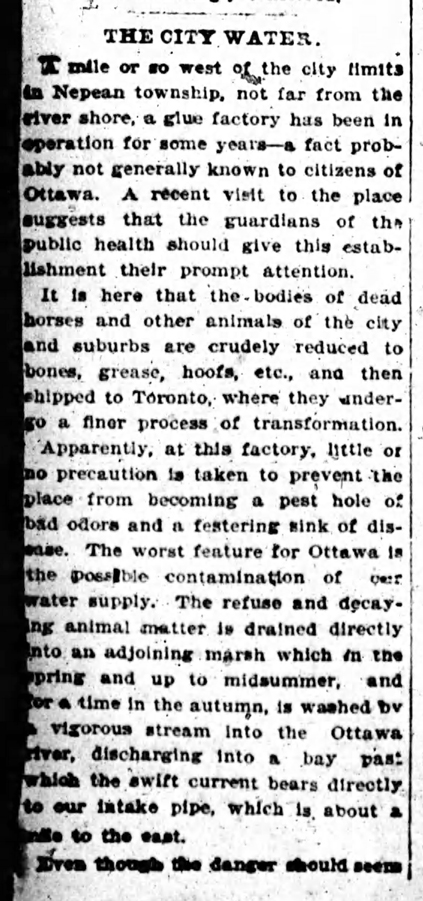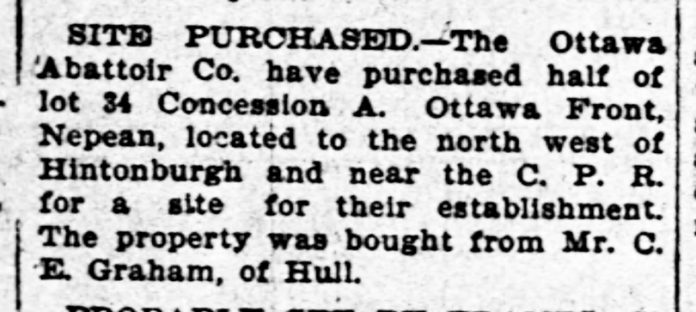By Dave Allston
Tunney’s Pasture will see a major redevelopment in the relatively near future, the details eventually to become public. For 70 years, it has been a public-service hub that hosts 10,000 federal servants daily (at least in non-pandemic times) on its 121 acres of grounds. But the federal-government era is just one part of an interesting, varied history for this exceptionally situated parcel of land.
For a couple of different projects, I’ve been digging into the history of the Tunney’s Pasture property. Over the next year or so, you’ll likely start seeing a few more Tunney’s-related stories in this column. In 2018, I wrote about the long-lost shantytown village of as many as 27 families at its peak who called the fields of the pasture home year-round, some for as many as 20 years.
This month’s column is about a topic that’s also as unexpected, about a massive planned project that saw a beginning, but never succeeded in being fully implemented. Had it been, Tunney’s and the surrounding neighbourhoods would have had quite a different history to tell.
In the late 1800s, the handling of stockyards and slaughterhouses was a topic of concern for all cities. Butchers needed meat and many kept their own animals, processing the meat themselves. However, to perform these functions was no easy task. One needed space for maintaining the pens, facilities to slaughter the animals and a method of disposing of the remnants.
In Ottawa, the killing of cattle within the boundaries of the city was illegal at the time. But it was known that the butchers were killing cattle in the city — the practice was winked at by Dr. Robillard, Ottawa’s medical health officer. The butchers stated in response that the police chief had said he would never fine a butcher for killing cattle in the city until the corporation provided a public place where slaughtering could be done.
Yet the entire operation was expensive; difficult to maintain properly and safely and, of course, it caused strained relationships with neighbours. Though some butchers did have their own facilities, most turned to having meat secured and shipped in (at high transportation costs) from Montreal and Toronto, driving up the price of meat considerably.
Thus by the summer of 1898, the butchers of Ottawa got together to discuss the establishment of a shared, central public stockyards and abattoir. That July, the Butchers Association of Ottawa incorporated a company, the Ottawa Stock Yards and Abattoir Company, and began to explore options, costs and a location. An ideal location was said to be outside of, but close to, the city limits; distant from a residential area and located next to a railway line.
The proposed operation was to include “stock yards for cattle, horses, sheep, swine and poultry, and an abattoir for the slaughtering of cattle and others…refrigerators to preserve the meat after being dressed, and a fertilizing plant for manufacturing all refuse and objectionable matter into fertilizing products.” The facilities would be for use by all local farmers, the proposal accommodating up to 75 city butchers, and would also lead to the employment of a “large number of men.”
The group argued that the city should provide a grant of land and exemption from water charges, though they were unsuccessful in lobbying for these.
Instead, the butchers investigated on their own, and agreed on a large portion of the vacant Tunney’s Pasture property. Negotiations were made late that fall with Nepean Township, and, on Dec. 20, 1898, the sale was finalized. The Ottawa Stock Yards and Abattoir Company acquired 48 acres of land, comprising the east half of lot 34 in concession A (essentially the land between what is now Banting and Goldenrod) for the sale price of $6,000.
The following months were spent campaigning Nepean Township for taxation exemption (they didn’t get it), and for a grant from the City of Ottawa for $3,000 per year towards maintenance, claiming that what they were building was for the greater public good. Though the vast majority of the council supported the grant, it did not pass due to a voting technicality.
Meanwhile, directors of the company announced in late January of 1899 that “immense slaughter houses and refrigerators would soon be built.” They visited Montreal in March to view the Montreal abattoir for ideas.
Limited operations at Tunney’s began in the spring of 1899. Some animals were housed on the site, and it appears a small structure of some kind was built as a temporary slaughterhouse and “glue factory” (in that era, glue was made from the hooves, skin, bones and tendons of horses, as well as cattle and pigs). But without the support from either Nepean or Ottawa officials, the group was not able to build the massive operations that they had dreamt of initially: no massive fridges; no railway siding; no huge slaughterhouse.
In October of 1900, the Ottawa Journal wrote about the glue factory.

“A mile or so west of the city limits in Nepean Township, not far from the river shore, a glue factory has been in operation for some years — a fact probably not generally known to citizens of Ottawa. A recent visit to the place suggests that the guardians of the public health should give this establishment their prompt attention. It is here that the bodies of dead horses and other animals of the city and the suburbs are crudely reduced to bones, grease, hoofs, etc., and then shipped to Toronto, where they undergo a finer process of transformation,” the article reads.
“Apparently, at this factory, little or no precaution is taken to prevent the place from becoming a pest hole of bad odours and a festering sink of disease. The worst feature for Ottawa is the possible contamination of our water supply. The refuse and decaying animal matter is drained directly into an adjoining marsh which, in the spring and up to midsummer, and for a time in the autumn, is washed by a vigorous stream into the Ottawa River, discharging into a bay past which the swift current bears directly to our intake pipe, which is about a mile to the east…There seems to be a warrant for investigation by the city health office,” it continues.
In December of 1900, the glue factory was causing concerns to the nearby neighbours just south of Scott Street in the small neighbourhood of “Ottawa West” (around Carleton Avenue). The residents complained to the Nepean Township board of health, who obtained an order from the provincial Board of Health with directions on what was to be done to put the factory in a sanitary condition, failing which it would be forced to close down.
By the following summer, the slaughterhouse and glue factory had indeed been shut down. A story in the July 1901 Ottawa Journal noted: “A valuable horse belonging to Mr. F.W. Mahon died yesterday morning. The intense heat is supposed to have caused death. Some difficulty was experienced in getting anyone to remove the dead animal, as the glue factory at Ottawa West has been closed up by the Nepean board of health.”
It appears the company was unable, or unwilling, to make the changes requested the year prior by the Board of Health, and so the factory closed, and was demolished soon after.
By 1909, the Ottawa Stock Yards & Abattoir Company went into the real estate business instead, likely tired of paying taxes on the vacant property with no future. They laid out an unsuccessful subdivision plan called “Eldonwood Park,” and later sold the land to an investor with a whole new idea.
Meanwhile, the debate over the construction of a civic abattoir would rage in Ottawa well into the late 1920s. Health officials would regularly bring to light the appalling conditions of some of the production and handling of meat in Ottawa, and politicians and residents would debate the topic regularly for years, but a public abattoir facility would never come to Ottawa.
Years later, Champlain Park residents would report discovering large numbers of teeth lying on or close to the surface of the ground in the vicinity of the neighbourhood. One long-time resident remembered finding teeth and asking her grandmother about them, who told her of the old glue factory.
Just one more story (and a what-could-have been) in the long, captivating history of the Tunney’s Pasture property!
Sign up now for my free Historical Society of Ottawa presentation on the history of Tunney’s Pasture, Sept. 29, at tinyurl.com/HSO-allston
